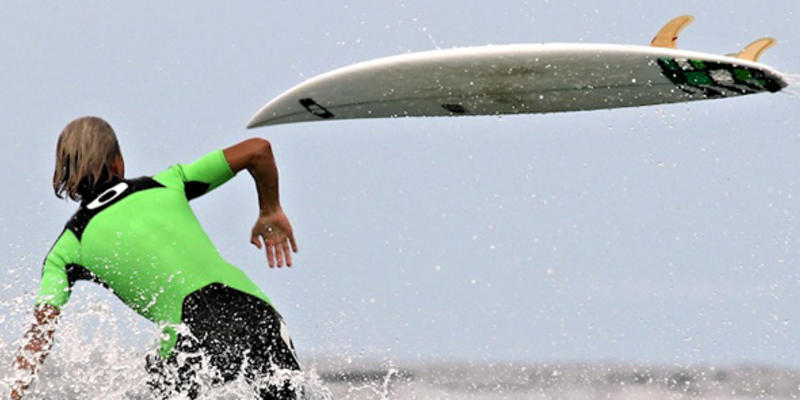
A friend of mine called after a surf session recently and asked what my opinion is on wearing a leash.
He had been surfing the friendly waters of Folly’s mostly mellow 9th Block East. It’s a place where the waves are fun, and most people surf there because the crowd is mellow. And by mellow I don’t mean uncrowded, but it’s a place where I will take my little girl. Everyone seems to be on a reasonable wavelength (no pun intended) at 9th Block.
After surfing a wave to the inside, my friend was paddling back out when a longboard came bouncing at his head. A surfer had lost his board and was swimming in to get it.
According to my source, the guy was a novice on a longboard.
My buddy suggested the guy should wear a leash. And the guy unloaded a few choice expletives at him while suggesting he should mind his own business.
My friend posted his version of the incident on Facebook, which prompted a Facebook exchange about whether or not everyone should wear a leash when surfing at Folly.
For those who might not know, a leash is the polyurethane cord that attaches your board to your ankle with a Velcro cuff.
People were fairly opinionated about the issue.
I have been hit by a few boards myself, but I just chalk it up as part the hazards of being a surfer.
Of course, if you hit my kid with your untethered surf craft, this would be a blog about my stay at the Charleston County Detention Center and the offending leashless surfer dealing with hospital bills or funeral costs. But hey, no need to project.
Some hate to wear a leash. They believe it impedes their ability in the water. In all fairness to these folks, surfing without a leash can make you a better surfer. After all, if you don’t lose your board while surfing, it means you are staying on it. It also means you are talented enough to surf without a leash. Of course, most everyone opts to wear a leash when surfing a macking Third World reef break a quarter mile out to sea.
Some of the best surfers I know—both shortboarders and longboarders—like to surf without a leash in smaller conditions. I am guility of the same.
There is also an old-school sentiment among many surfers that leashes are for kooks who can’t surf.
The opposing school of thought is that leashes—especially worn at Folly Beach—are necessary so some poor kid wearing his swimmies in the surf zone is not pounded in the head by someone’s errant surfboard.
I have personally witnessed these kids try to catch a board as it glides surfer-less to the beach, only to have the kid (or parent) realize entirely too late that the surfboard is pretty heavy, and it is being pushed at high velocity by a wave more powerful than the kid probably realized. It’s not like catching a rubber raft as it bobs towards shore. A surfboard is hard and fairly heavy, especially in the case of a longboard. Put the force of the ocean behind it, and it can hurt someone.
My friend asked me my opinion on the matter. I have strong feelings about it.
First and foremost, it’s the law. Surfers are required to wear a leash at all times. I feel like surfing at Folly is a privilege, and a protected one at that. If someone in the surf zone is hit with a board, then Folly Beach could very well change the law regarding surfing. From mid-September until mid-May, Folly is wide open for surfing anywhere on the beach.
During the crowded summer months between the hours of 10:00 a.m. and 6:00 p.m., three blocks on either side of the Folly pier are reserved for swimmers. Surfers are always required to say 200 feet away from the pier at all times. Please ignore the pier fishermen yelling at you about the sign on the pier that reads, “Stay 300 feet away." They are drunk and can’t read anyway. It is actually 200 feet. That’s the law.
Also, you can be ticketed or (worst case) arrested if you do not wear a leash while surfing.
I sometimes worry if someone is hurt by just one errant surfboard ridden by a surfer with no leash, then the Town of Folly Beach might continue restrictions on surfing during crowded months.
It’s something to think about.
So, "to leash or not to leash?” That is the question.